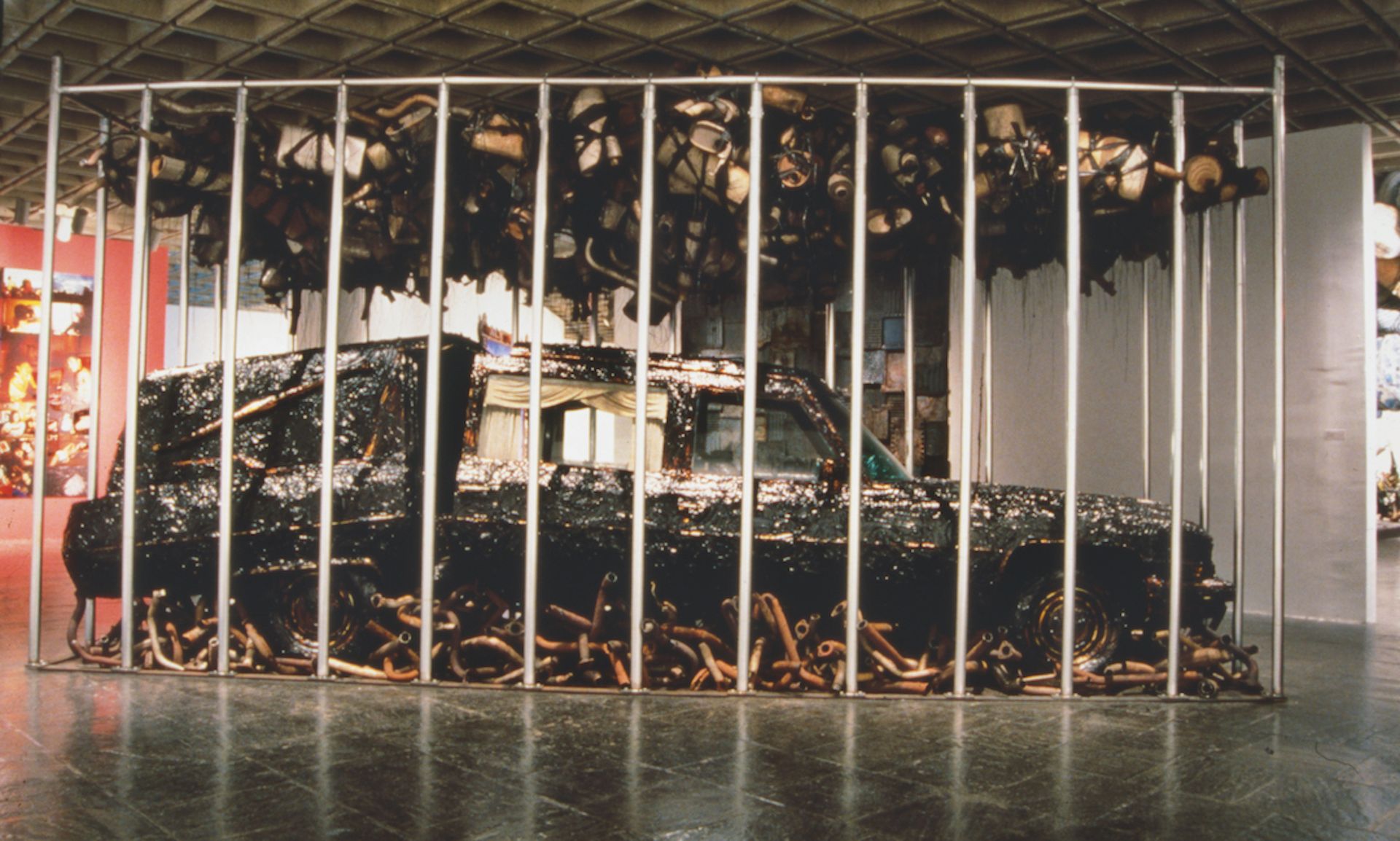Nari Ward’s monumental sculpture Peace Keeper—which was first exhibited at the 1995 Whitney Biennial, sat partially destroyed for decades and was then re-created in 2020—was acquired by the Baltimore Museum of Art (BMA) last month.
Among the artist’s most significant works, the sculptural installation features a cleaved, burnt-out hearse, tarred in black grease and adorned with peacock feathers, within a metal cage; discarded mufflers surround the vehicle and are suspended overhead. At the time of its debut, Peace Keeper—whose title derives from United Nations peacekeeping missions—was a standout of the Biennial, organised by curator Klaus Kertess. New York Times art critic Holland Cutter hailed it one of the show’s “most arresting sights”, possessing “spiritual grandeur”. Known for fashioning sculptures from objects scavenged around his Harlem neighbourhood, the then 31-year-old artist had recently completed his seminal Amazing Grace (1993), an installation of over 300 discarded baby strollers, a requiem for Black communities ravaged by the drug and AIDS epidemics.

Nari Ward, Amazing Grace (1993), installation view Nari Ward: We The People, 13 February-26 May 2019, New Museum New York Courtesy the artist; the New Museum, New York; and Lehmann Maupin, New York, Hong Kong, Seoul and London
Since then, Ward’s career has spanned video, painting and his signature assemblages of materials like TV sets and soda bottles, confronting social issues of race, poverty and consumer culture. When the artist’s mid-career survey Nari Ward: We The People opened at the New Museum in Manhattan in 2019, Amazing Grace was its centerpiece, but Peace Keeper was noticeably absent.
“After the biennial, the piece was in storage for ten years or so at my brother’s, in the backyard,” Ward says. “When my brother decided to sell his service station, I had to make a decision about the long-term expectation of the work. Although I did keep the cage, which was the catalyst for the whole idea, I had let the actual body of the vehicle go, so the piece wasn’t available for We The People.”
Ward remembers Kertess visiting him in Harlem to see Amazing Grace. “When Klaus approached me about the biennial, I think he wanted something as dramatic and powerful as my Amazing Grace piece,” Ward says. “And I always wanted to do the tail end of life’s journey. The beginning of life’s journey, in terms of moving through space, is the baby stroller. The end of that journey is the hearse taking the body to the cemetery or the funeral home.”
Ward’s funerary artworkremained dismantled for a quarter-century. It was the late, influential curator Okwui Enwezor who asked Ward to reconstruct the hearse for the New Museum’s 2021 exhibition Grief And Grievance: Art and Mourning in America, which gathered works by 37 artists in an urgent response to racial violence.

Peace Keeper (1995/2020) by Nari Ward on view at the 1995 Whitney Biennial Courtesy the artist and Lehmann Maupin, New York, Hong Kong, Seoul and London
“Peace Keeper is still about man’s inhumanity to man, because there’s something very violent in the piece. There’s a break in the vehicle, but there’s also a kind of release,” says Ward, who is preparing for his solo show, I’ll Take You There; A Proclamation, at Lehmann Maupin’s Chelsea flagship in April. “I wanted Peace Keeper to be a kind of generative battery, to give energy to ideas about trauma and change more than anything else.”
“I’m really interested in extending the privilege of impracticality to the artists of colour who are defining the present moment,” says Christopher Bedford, the BMA’s director and an outspoken champion of deaccessioning works to support greater diversity and equity in the institution’s collection. The museum acquired Ward’s sculpture Live Ball (2010), a basketball hoop of shoelaces, in 2011.
“I imagine Peace Keeper becoming the center of gravity in our contemporary west wing gallery,” says Bedford; the work is expected to be installed at the museum in 2023 or 2024. “It is a highly teachable object which stands out as it relates to the history of racial terror in this country just as it is incredibly pertinent to racial unrest at present.”


